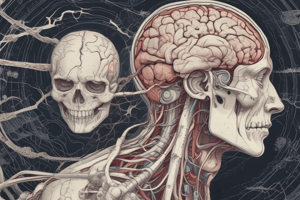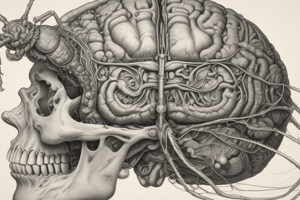Podcast
Questions and Answers
What is the primary function of the Peripheral Nervous System?
What is the primary function of the Peripheral Nervous System?
- Integration and processing of information
- Control of involuntary movements
- Regulation of body functions
- Transmission of information from the CNS to the rest of the body (correct)
What is the role of dendrites in a neuron?
What is the role of dendrites in a neuron?
- Transmit signals to other neurons
- Receive signals from other neurons (correct)
- Release neurotransmitters
- Process information from other neurons
What type of neuron transmits information from the CNS to muscles and glands?
What type of neuron transmits information from the CNS to muscles and glands?
- Interneurons
- Motor neurons (correct)
- Cerebellar neurons
- Sensory neurons
What is the process by which neurons communicate with each other?
What is the process by which neurons communicate with each other?
What is the role of the terminal buttons in a neuron?
What is the role of the terminal buttons in a neuron?
What is the function of the Central Nervous System?
What is the function of the Central Nervous System?
What is the primary function of neurotransmitters?
What is the primary function of neurotransmitters?
Which of the following neurotransmitters is involved in motivation and reward?
Which of the following neurotransmitters is involved in motivation and reward?
What is the primary function of the cerebellum?
What is the primary function of the cerebellum?
What is the term for the proportion of variation in a behaviour that can be attributed to genetics?
What is the term for the proportion of variation in a behaviour that can be attributed to genetics?
What is the process by which neurotransmitters are terminated?
What is the process by which neurotransmitters are terminated?
Which structure is involved in forming and consolidating new memories?
Which structure is involved in forming and consolidating new memories?
Flashcards are hidden until you start studying
Study Notes
Nervous System
- The nervous system consists of:
- Central Nervous System (CNS): brain and spinal cord
- Peripheral Nervous System (PNS): nerves that connect CNS to the rest of the body
- Functions:
- Integration and processing of information
- Control of voluntary and involuntary movements
- Regulation of body functions (e.g. heart rate, blood pressure)
Neurons
- Basic units of the nervous system
- Consist of:
- Dendrites: receive signals
- Cell body: processes information
- Axon: transmits signals
- Terminal buttons: release neurotransmitters
- Types of neurons:
- Sensory neurons: transmit information from senses to CNS
- Motor neurons: transmit information from CNS to muscles and glands
- Interneurons: integrate and process information within the CNS
Neurotransmission
- Process by which neurons communicate with each other
- Steps:
- Synthesis: neurotransmitters are produced in the terminal buttons
- Storage: neurotransmitters are stored in vesicles
- Release: neurotransmitters are released into the synapse
- Binding: neurotransmitters bind to receptors on the postsynaptic neuron
- Signal transmission: signal is transmitted to the postsynaptic neuron
- Termination: signal is terminated through reuptake or breakdown of neurotransmitters
Neurotransmitters
- Chemical messengers that transmit signals between neurons
- Examples:
- Acetylcholine: involved in muscle contraction, memory, and learning
- Dopamine: involved in motivation, reward, and movement
- Serotonin: involved in mood regulation, appetite, and sleep
- Norepinephrine: involved in attention, arousal, and stress response
Brain Structures
- Cerebrum: divided into two hemispheres, responsible for higher-level thinking and processing
- Cerebellum: coordinates movement and balance
- Brainstem: regulates basic functions such as breathing, heart rate, and blood pressure
- Limbic system: involved in emotions, motivation, and memory
- Hippocampus: plays a key role in forming and consolidating new memories
Genetics and Behaviour
- Genes influence behaviour through the expression of proteins and neurotransmitters
- Epigenetics: environmental factors can influence gene expression
- Heritability: the proportion of variation in a behaviour that can be attributed to genetics
- Gene-environment interaction: the interaction between genetic and environmental factors that influences behaviour
Nervous System
- Consists of Central Nervous System (CNS) and Peripheral Nervous System (PNS)
- CNS includes brain and spinal cord, while PNS includes nerves that connect CNS to the rest of the body
- Functions include integration and processing of information, control of voluntary and involuntary movements, and regulation of body functions like heart rate and blood pressure
Neurons
- Basic units of the nervous system, consisting of dendrites, cell body, axon, and terminal buttons
- Dendrites receive signals, cell body processes information, axon transmits signals, and terminal buttons release neurotransmitters
- Types of neurons include sensory neurons, motor neurons, and interneurons
- Sensory neurons transmit information from senses to CNS, motor neurons transmit information from CNS to muscles and glands, and interneurons integrate and process information within the CNS
Neurotransmission
- Process by which neurons communicate with each other through neurotransmitters
- Neurotransmitters are synthesized in terminal buttons, stored in vesicles, released into the synapse, bind to receptors on the postsynaptic neuron, and transmit signals
- Signal transmission is terminated through reuptake or breakdown of neurotransmitters
Neurotransmitters
- Chemical messengers that transmit signals between neurons
- Examples include acetylcholine, dopamine, serotonin, and norepinephrine
- Acetylcholine is involved in muscle contraction, memory, and learning
- Dopamine is involved in motivation, reward, and movement
- Serotonin is involved in mood regulation, appetite, and sleep
- Norepinephrine is involved in attention, arousal, and stress response
Brain Structures
- Cerebrum is divided into two hemispheres and is responsible for higher-level thinking and processing
- Cerebellum coordinates movement and balance
- Brainstem regulates basic functions like breathing, heart rate, and blood pressure
- Limbic system is involved in emotions, motivation, and memory
- Hippocampus plays a key role in forming and consolidating new memories
Genetics and Behaviour
- Genes influence behaviour through the expression of proteins and neurotransmitters
- Epigenetics: environmental factors can influence gene expression
- Heritability is the proportion of variation in a behaviour that can be attributed to genetics
- Gene-environment interaction influences behaviour through the interaction between genetic and environmental factors
Studying That Suits You
Use AI to generate personalized quizzes and flashcards to suit your learning preferences.




